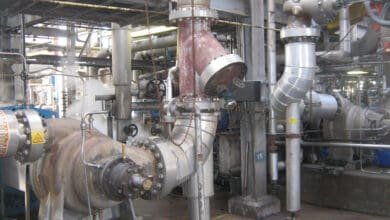Condition monitoring reaches new heights

With the use of condition monitoring solutions as part of building management systems on the rise, Renew looked at how facilities management company CBRE is using a system from Fletcher Moorland, powered by technology from Turck Banner, to ensure the efficient and effective running of a range of pumping systems used in the flagship Scalpel building in the City of London.
Completed in 2018, the London-based commercial skyscraper, the Scalpel, is 190m high and comprises 38 floors. Naturally, for CBRE, the facilities management (FM) company looking after the building, it is imperative to ensure its tenants are comfortable, and that the building’s services are delivered without interruption, and to do so within a strict budget. A complex HVAC system manages the interior environment, and this must remain operational 100% of the time, with all efforts made to avoid system failures or breakdowns.
Often, in buildings of the Scalpel’s scale, there will be a planned maintenance programme designed to ensure system parts and components are checked to a schedule and, where necessary, repaired or replaced before there is any chance of failure. But this is not ideal, as before they are discovered, emerging issues may be allowed to develop to a point where replacement is the only option. This is something the CBRE team recognised, and they sought out a condition-based monitoring solution that would be more effective – not only from a cost perspective but also from the quality of the building’s environment.
The FM company chose the Meerkat solution from Fletcher Moorland for its building, as the company’s Managing Director, Matt Fletcher, explained: “With the project out to tender, we were approached by the building’s facilities team, who had heard about Meerkat and were keen to find out about the system.
“Many condition monitoring systems are highly complex, and a deep understanding of vibration analysis is required to use them properly. We intentionally designed Meerkat to be very simple from a user’s point of view. We took a demo system to the site and left it online for a few weeks so the facilities company could get a feel for it. They loved it, and it was indeed its simplicity that won us the contract.”
The Meerkat solution is a complete condition monitoring system that can be as simple as fit and forget or integrated into wider building management systems with a wide range of parameters defined by the user. It can be fitted and fully managed by the Fletcher Moorland team or set up and monitored by the on-site team at the site being monitored. A typical system will comprise sensors, or points – sensing parameters such as vibration, temperature, and, where needed, speed output from the inverter drives. Each point is connected to a network node powered by a battery that lasts, on average, two years. All the nodes are then meshed together over a wireless network, which sends data to a central gateway in the building. Much of the sensing and wireless technology employed in the Scalpel’s solution, and many other Meerkat installations, is supplied by automation equipment specialist Turck Banner.
The fact that the Meerkat system can operate over a wireless network is a big advantage at the Scalpel. The building has a plant room in the basement and one on the top floor. This would require vast amounts of cable – challenging to route through the building and adding to the project cost.

Indeed, the system installed at the Scalpel has over 150 sensors, or points. Some assets have more than one sensor attached; for example, a large pump may need two sensors on the pump itself and two on the motor. How this is set up is where the expertise of the installation team comes into play. Fletcher Moorland’s installation team is vibration analysis certified and uses a combination of experience and the parameters set out in ISO 10816 to establish how best to monitor each asset.
The Meerkat software takes the data, and after a baseline is established, thresholds are set. Ongoing data is then monitored, and an alarm can be triggered if any thresholds are breached.
The main benefit of condition monitoring systems is typically avoiding unplanned downtime. In the Scalpel’s case, this means ensuring the best possible service is delivered to its landlord and tenants; in some FM examples, there can even be significant financial penalties for unplanned system downtime. In industrial settings, unplanned downtime can have huge financial implications, with lost production, wasted materials, etc. And in some circumstances, there can be critical safety issues. But for the CBRE team at the Scalpel, there are other benefits to taking a condition-based monitoring approach.
One of the benefits CBRE is experiencing in the Scalpel relates to the replacement of assets, as John Dennis, Account Manager at CBRE Global Workplace Solutions, explained: “We would typically have a budgeted replacement cost for a pump based on the manufacturer’s expected lifespan. However, when monitoring the actual condition of the asset, we might find that the pump’s condition remains well within tolerance for longer than expected, allowing the replacement period to be elongated and the associated cost to be delayed.”
There are further potential financial benefits of employing a condition-based monitoring system, which can be gained from reducing energy usage. John continued: “The Meerkat solution will indicate if a pump has to work harder than anticipated to deliver the same results. If it is, it will be using more energy, which can soon add up when you have as many pumps as we have here.”
The ability to optimise energy usage has financial and environmental benefits, which are very important to the CBRE team.
Another environmental benefit comes from being able to repair rather than replace an asset; as Matt Fletcher, Managing Director of Fletcher Moorland, explained: “By refurbishing a pump, the energy inputted is a lot less than having to bring in a new pump. Assuming the efficiency of a replacement pump is the same as the original, being able to extend its operational life can have significant benefits in terms of carbon reduction.”
Having a condition monitoring system in play is enabling other changes to the maintenance practices employed by the CBRE team. Under a more traditional planned maintenance approach, the greasing of assets would be carried out on a time-based schedule. Working on a condition-based monitoring basis has improved this regular task, as John explained: “We have put a greasing schedule into Meerkat. Rather than greasing a pump or its motor on, say, a six-month schedule, we have a link to the system’s inverter and can see exactly how many operational hours it has run for. When the system gets to within 100 hours of greasing being due, we will be automatically notified and can grease exactly as needed.”
Ease of use
According to the CBRE team, the ease of use ultimately led to the Meerkat system being chosen. As well as the installation benefits already mentioned, the fact that it is an open system means it is more accessible than some alternatives, and this has made integration much easier, as Tony Coghlan, Managing Director at Turck Banner, added: “There are companies that see the hardware as a commodity and place the value in the software. This can mean expensive subscriptions and the data being locked into the system. It was important to us at Turck Banner and the Fletcher Moorland team that this was an open protocol. For CBRE, this has meant it is much easier to bring the data being collected into their building management system and be innovative in how the system is adapted and developed to their needs, such as with the greasing schedule.”
A system in action
The Scalpel’s chiller room is on the 37th floor. It houses six chillers, which provide chilled water to air handling units and fan-cool units across the entire building. If the chiller system goes down, cooling for areas including the transformer rooms, lift motor rooms, and, of course, the tenants is lost.
When one of the condense pumps started to fail, the Meerkat system was able to give the CBRE team an early warning. John tells the story: “A bearing on the pump system had started to fail prematurely, much earlier than expected. The fact that the Meerkat system was able to indicate an anomaly early on gave us much more time to work with the manufacturer, who came in, surveyed the pump and ordered the correct seals, bearings and lifting equipment. As a result, we were able to swap the bearing before it actually failed.
“Now we also keep bearing and seal kits for these on site as part of our critical spares inventory. If another potential failure is indicated, we can replace them much more quickly.”
It’s clear from the example at the Scalpel that having a condition-based monitoring solution as part of the building management system brings a wide range of financial and environmental benefits. The ease of use and flexibility of this open solution certainly enable those benefits to grow as the system in place is developed.







